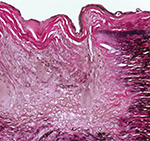 In 2009, the European League Against Rheumatism (EULAR) published recommendations for the management of large vessel vasculitis. In the time since, researchers have published new data on the diagnosis, monitoring and treatment of this condition, and the new evidence has been incorporated into the 2018 recommendations.1 Ana F Agueda, MD, a rheumatology trainee at Centro Hospitalar do Baixo Vougar EPE, Portugal, and colleagues performed the extensive literature review used to inform the 2018 recommendations on one portion of the new guideline: the management of Takayasu arteritis. They published the results of their systematic literature review in the September 2019 issue of RMD Open.1
In 2009, the European League Against Rheumatism (EULAR) published recommendations for the management of large vessel vasculitis. In the time since, researchers have published new data on the diagnosis, monitoring and treatment of this condition, and the new evidence has been incorporated into the 2018 recommendations.1 Ana F Agueda, MD, a rheumatology trainee at Centro Hospitalar do Baixo Vougar EPE, Portugal, and colleagues performed the extensive literature review used to inform the 2018 recommendations on one portion of the new guideline: the management of Takayasu arteritis. They published the results of their systematic literature review in the September 2019 issue of RMD Open.1
The literature review identified observational studies that provided low-level evidence to guide the monitoring and treatment of patients with Takayasu arteritis. The authors used a comprehensive research strategy and selected 287 articles for review. They note the heterogeneous nature of the articles made it impossible for them to perform a meta-analysis. Additionally, because Takayasu arteritis is a less common subtype of large vessel vasculitis, the recommendations are supported by less data than recommendations for more common forms. The researchers call for more, higher quality studies on the diagnosis, management and treatment of this rare disease.
Unlike the giant cell arteritis (GCA) form of large vessel vasculitis, which presents with a classical cranial pattern of symptoms, the presentation of Takayasu arteritis is heterogeneous and has no clear pattern. Patients with Takayasu arteritis not only have vascular symptoms, but may also present with systemic symptoms, such as fever, weight loss and malaise. The investigators found sex and age were both associated with some differences in disease manifestations. Men with Takayasu arteritis tended to have a greater risk of abdominal pain and ascending aortic aneurysm than women with Takayasu arteritis. Men also tended to have an increased frequency of involvement of abdominal aorta, as well as more complications. In the studies, men more often experienced the common complications of hypertension and aortic valve regurgitation than women.
Patients who were older than 40 at the time of symptom onset tended to have a more diffuse pattern of vascular lesions and a higher rate of complications. The presence of major complications, being older than 40, a progressive disease course and a weaker inflammatory response were all associated with a more unfavorable prognosis.
The researchers found no evidence detailing the best disease-monitoring scheme. They note that because the consequences of disease progression in Takayasu arteritis may be severe, rapid diagnosis and treatment can reduce the likelihood of vascular damage. They recommend medical centers establish fast-track clinics, such as those used for GCA, to help manage the treatment of patients with Takayasu arteritis.


